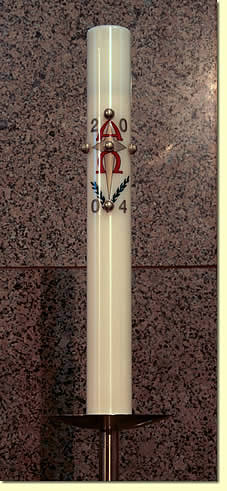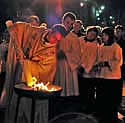 St Mary's Church, Dymock
St Mary's Church, Dymock
| Admin | |||
| . | Home | Contents | |
| H&S Policy | People Safety | Grave Yard | |
The Church & The World
Faith & Care
Faith & Care
Things Past
People & Features
People & Features
Seasons and Festivals

As well as the Seasons and Major Festivals, the church celebrates several 'Special Days' throughout the year to remember, honour or support our work in God's world. Celebration of the Special Days is usually optional, Christians chose which they want to include. Click here to view the 'Special Days'.

.
Easter is the culmination of Jesus' purpose in coming to earth in human form - to make amends for human sin by obeying God perfectly. The Festival of Easter marks the beginning of the season of 'Eastertide', which lasts 50 days until Pentecost, and is the subject of great festivity and rejoicing.
.
The customs associated with Easter vary considerably from country to country and between different denominations but usually include the most elaborate of the church Services held during the year. They include the Easter Vigil, Service of Light, Sunrise Service, and Easter Holy Communion.
.
(The Easter story has been illustrated by 6 displays arranged around Dymock church. (Click here to see the displays).

A Pascal candle
.
It usually starts with a fire lit by the priest outside the church, which symbolises the radiance of Jesus dispelling the darkness of sin and death, and from which a large Paschal candle is lit (The word 'Paschal' is derived from 'Passover'). The lighted candle is carried into an otherwise dark church declaring in a loud voice, 'The Light of Christ'. Other candles are lit from this one candle as it moves towards the front of the church, until the church is ablaze with light (when the electric lighting may be turned on). There will usually follow the chanting of the 'Exsultet' or Easter Proclamation declaring that Christ is risen and has conquered sin and death.
.
The celebration continues with a 'Service of the Word' in which seven or more sections of the Bible's 'Old Testament' are read depicting the history of the Jews, especially those parts pointing towards Jesus, with special emphasis on the crossing of the Red Sea, because that relates to the time of Passover. The 'Gloria in Excelsis' will be sung, together with the use of the word 'Alleluia' (Hebrew for 'Praise the Lord') which is especially associated with Easter. At this point in the celebration people were traditionally baptised or confirmed into full membership of the church, and the Service may today include a renewal of baptism vows by everyone present.
.
The Service continues with a celebration of Holy Communion in the usual way, but with especially joyful Easter Anthems. The whole symbolises the resurrection and return of Jesus, the 'Light of the World' and our joyful receiving of the 'Good News' that he succeeded in his purpose of coming to earth and there is now reconciliation between God and humanity and the prospect of life after death. (Return to Top)

For instance, the Service of Light may take the form of the lighting of a fire outside the church at dusk on Holy Saturday and the carrying of the Paschal candle into the dark church with the words 'The Light of Christ' or 'Christ is Risen', followed by a short 'Service of the Word' omitting the many Old Testament readings and 'Exsultet' but including the 'Gloria in Excelsis' - the first time that has been sung since before Lent. The Service ends there and the people depart, delaying the celebration of Holy Communion until the usual time the following morning. Dymock has used this last format in the recent past, although not in the last few years, now we use only the Easter Sunday morning Service.

